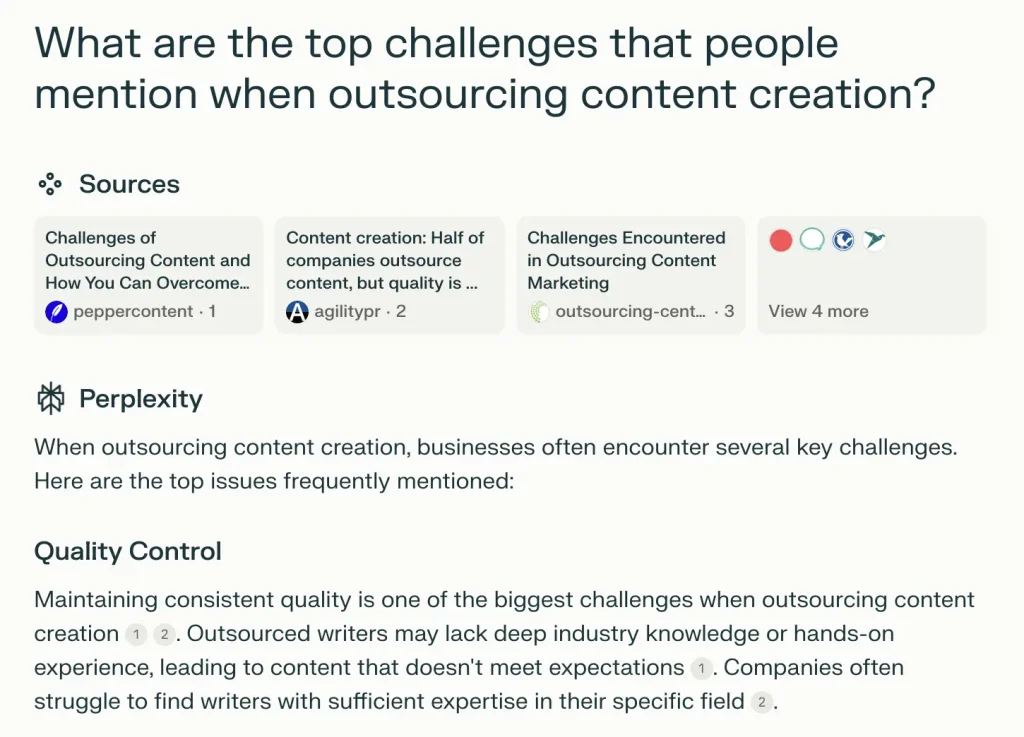One concern for outsourcing content that I hear often is the worry that external writers won’t be able to produce content with the same unique insight and perspective as an internal team member.
I even asked Perplexity what the top challenges for outsourcing content were and quality control was the number one concern …

So … it comes up a lot. I’ve spoken with many CEOs and marketing leaders that have worked with writers whose work has been disappointing — making these leaders skeptical of working with external writers ever again.
“How can a contractor write an article with the same level of knowledge about our company or industry as one of our team members?”
It’s a valid point and I understand the concern. I’ve been on both sides and I know how frustrating it can be to have to work through constant revisions because the article did not meet expectations.
I’ve been a freelance writer, I’ve been an agency owner, and I’ve run content creation internally at a fast-growing SaaS startup. Unfortunately, I’ve been on both the receiving and delivering side of said unsatisfactory content.
A few years after I started my career as a freelance writer, I started working with a new client in the data privacy space. Admittedly, I knew nothing about data privacy but I did know how to create SEO content and I had success creating content for other B2B SaaS companies that ranked highly in Google. Still, the end results didn’t pan out so well …

It pains me to share this email 😭
I was pretty bummed. I just started working for the company and I thought they would be a good, steady client (they paid pretty well at the time). I even tried multiple times to revise the piece with their feedback in mind. But our visions were misaligned and I wasn’t able to get it there for them.
It was frustrating for me — going back and forth on edits, eating into my profits (I charged per article) and never getting it to a point where the client was happy. And I’m sure it was frustrating for them — a CEO taking time away from his busy schedule to provide several rounds of feedback and revise my work, only to not be happy with the final article.
I’ve had the same thing happen to me while working with writers (this time, as the client). So I know what it’s like. The hope, the potential, then the eventual letdown, and frustration.
Still, it was a good learning experience. I learned not to work with businesses that are in a highly technical space, which I know nothing about. And I learned to niche down even further, and only work with businesses that I have knowledge in.
There are certainly pros and cons to outsourcing versus internal writing. I’m sure in an ideal world, you’d have someone on your team who deeply understands your company and your industry write every single piece of content on your website.
But that’s not realistic for most SaaS businesses.
Very few hire a full-time writer whose only responsibility is writing new content — nor do most SaaS businesses have a budget for this role, especially considering the added expense of full-time employees (FTEs). FTEs have added costs like company benefits, taxes, healthcare, and so on. Not to add in the complication of letting an FTE go if things don’t work out.
Typically, this responsibility falls onto the plate of another marketing team member that manages multiple marketing initiatives (e.g., Digital Marketing Manager, Product Marketing Manager, etc.). Even when there is someone on your team who can write content and has industry experience, writing new content often seems to be low on the priority chart.
When it comes to product-led content, this is often the responsibility of a product marketer. Someone who is also juggling other key areas like running sales enablement, optimizing positioning and messaging, defining GTM strategies, creating customer case studies, and so on.
You’ll be lucky if that person can publish one blog post per month. This is not great for establishing consistency or growing website traffic. With that in mind, outsourcing can be an effective way to build a consistent content program if you find the right person and you follow a few guiding principles.
After 10 years of SEO content creation — working both as a writer and as a manager — I’ve discovered several ways to ensure that content aligns with brand messaging. In other words, here’s how to have external writers create content that sounds like you wrote it — and not be disappointed.
1. Find The Right Writer And Make Sure They Specialize In Your Industry
First, make sure you spend the time to properly research, assess, and vet potential writers. I already covered this process in-depth here, so I won’t go into too much detail again. But in summary …
- Evaluate previous writing samples (ideally, published articles so you can verify that the writer actually wrote them)
- If possible, speak to referrals
- Use paid test assignments to assess the writer’s skills and subject knowledge (possibly even evaluating multiple writers at one time, and choosing the best fit)
Just as importantly, make sure you choose a writer, contractor, agency, etc. who has experience creating content in your space and/or for your target audience. If you’re a SaaS platform for developers, make sure the writer has produced content for this type of technical audience.
DO NOT go with a generalist.
This will only require more time on your end (in terms of management, revisions, providing feedback, etc.) and you’re likely to be disappointed. A generalist may be cheaper, but you get what you pay for. It’s not worth the headache. This is especially important for technical industries that require years of experience and education (i.e., Healthcare, Law, etc.).
Make sure the writer has published article samples that are relevant to your space (e.g., articles published on industry websites or at least as close as possible).
Pro tip
It can be worth it to have multiple writers for different levels of technical writing.
For instance, you could have a writer knowledgeable in your space but who doesn’t have a technical background (e.g., a writer who has written about software engineering but hasn’t worked as an engineer or doesn’t have a technical degree).
They can handle “higher-level” SEO topics where most of the research can be done by evaluating current ranking results and supplement content by conducting interviews with internal team members or industry experts as needed.
Then, you can work with an actual software engineer to write more technical content where a more formal background is needed. One of the drawbacks, though, is software engineers aren’t always the best writers, so additional editing may be necessary.
2. Organize Your Thought Leadership And Product Enablement Content
It’s likely you already have several articles, guides, videos, etc. that you can use to educate writers. They can use this existing content to learn more about your business and inject similar concepts into any content they create.
From an SEO perspective, your goal is to match search intent — which will mean not talking about your business 90% of the time.
For instance, let’s say your company’s product is a Business Intelligence SaaS platform and you want to target the keyword, “BI Tools” (which should be a high-intent search for your industry). Searchers are actively looking for a solution and hoping to evaluate different options. They expect to find results that list different tools in this space. Meaning, you WILL need to include other BI tools besides your own to match search intent and give yourself a chance to rank for this keyword.
90% of the content will be aimed at providing context around this search — answering subtopics like “What should you look for in a BI tool?” — while also providing a list of top tools in the space. This can be accomplished by the writer conducting thorough research. Yet, you will also have a chance to talk about your business, why visitors might be interested, what features you have that stand out, etc.
It’s likely the writer can draw talking points from your existing content — your homepage, solutions pages, existing product blog posts, case studies, ebooks, and so on.
The goal is not to sell immediately to the visitor. You’re creating awareness and then directing them to other parts of your website to learn more or sign up for your product/request a demo.
I recommend compiling a list of helpful content that you already have created and sharing that with writers so they can get up to speed quickly. Have them read it fully before they start writing for your company. Have them bookmark important content pieces so they can refer back to them and grab information to talk about your business, pull quotes, etc.
Some potential ideas include your website homepage, any product or thought leadership blog posts your executive team has written, and industry ebooks you’ve created. For instance, at CloudZero, we have “The Cloud Cost Playbook” and “The Modern Guide To Managing Cloud Costs”. Both guides serve as great jumping-off points for people to learn more about our space and business.
3. Conduct SME Interviews
SME stands for Subject Matter Expert. These are key people on your team and/or in your industry that have in-depth knowledge and expertise. If you’re a SaaS platform for software engineers, and all the content you create is for software engineering leaders, this could be your CTO or VP of Engineering. If you’re a Martech platform, this could be your CMO.
These people deeply understand your space, your business, and can provide real insight into various topics you want to write about. Have your writer interview these people while creating new content.
This doesn’t have to be a big lift — 30 minutes for an article will often do it. Or, even an introductory interview to learn about your business can help the writer gather some snippets for future use. I’ve seen several agencies that take this approach now. And it is one of the best ways to get around the “I don’t trust an external writer to be able to write about our business” concern.
Your CTO isn’t going to take six hours to write a blog post themselves. They’re too busy. But 20-30 minutes to interview directly with a writer to provide them with direct insight is completely doable.
4. A Few More Quick Points For Success
The three previous tactics outline the best ways to get around the quality control concern.
Yet, it’s worth calling out a few other general content creation best practices — as they, too, will help ensure the highest, and most accurate level of content produced.
Avoid content mills
Content mills are websites that specialize in high-volume, often low-quality, content at very cheap rates. There’s a reason they’re so cheap.
Writers are often generalists, sometimes they don’t even speak the language they’re writing in very well, and often they’re under immense pressure to turn around content quickly (sacrificing quality and time spent understanding your business).
Stick with the same writer
It’s simple: the longer you work with a writer, the more they will begin to understand your business. That’s why it’s vital to find someone you like at the beginning of establishing your content program.
Follow the steps I’ve outlined and take the time needed to find a good fit. The first writer you try might not be the writer you stick with for the long term.
Provide detailed content briefs
Be as thorough as possible. Writers aren’t mind readers. If you don’t communicate what you want covered (and how), you leave it up for interpretation. Be clear.
Add any subtopics that make sense to include for your target keyword (by analyzing current ranking results and related keywords). Include any added perspective you have on that topic where possible. It may seem like more work upfront, but a thorough outline will save you from disappointment and added revisions.
Have writing guidelines ready to go and share them with new writers
Again, be as clear as possible. Outline your writing style, tone, and formatting guidelines. Be detailed. Writing guidelines help new writers understand whether your brand writes in a more straightforward, to-the-point tone or has room for playfulness.
They let writers know what words to avoid, how to format text, where to include images, how to include citations, and so on. The point is a well-laid-out set of writing guidelines will help writers get to the end result quicker — and limit the number of revisions needed.
Avoid having too many cooks in the kitchen
I recommend having one main point of contact at your company that will review each content piece and work back and forth with the writer. While it can occasionally be beneficial to have multiple people within your company review certain articles, the more people reviewing content, the more this slows down the content creation process.
It also makes it confusing for the writer (each person reviewing the content will have their own opinion on how things should be worded, structured, etc.). It becomes impossible for the writer to know whose requests to satisfy (again, this is where writing guidelines can be your source of truth). If possible, pick one person to be the manager, and this will make the content creation process run smoother and faster.
In Summary …
Outsourcing content creation can be a challenge, especially when the fear is that external writers won’t match your company’s tone or expertise. However, with the right approach, you can get high-quality content that aligns with your brand.
The key lies in …
- Finding writers who specialize in your industry;
- Providing them with detailed briefs and internal resources;
- And facilitating interviews with SMEs when needed.
Ultimately, the right writer will create content that sounds like you wrote it, ensuring a seamless collaboration without disappointment.


.svg)



.svg)